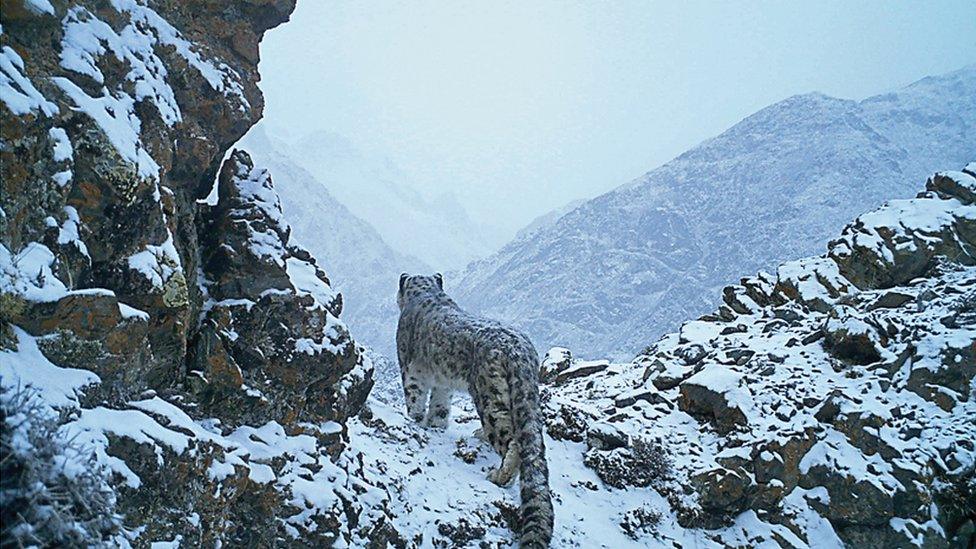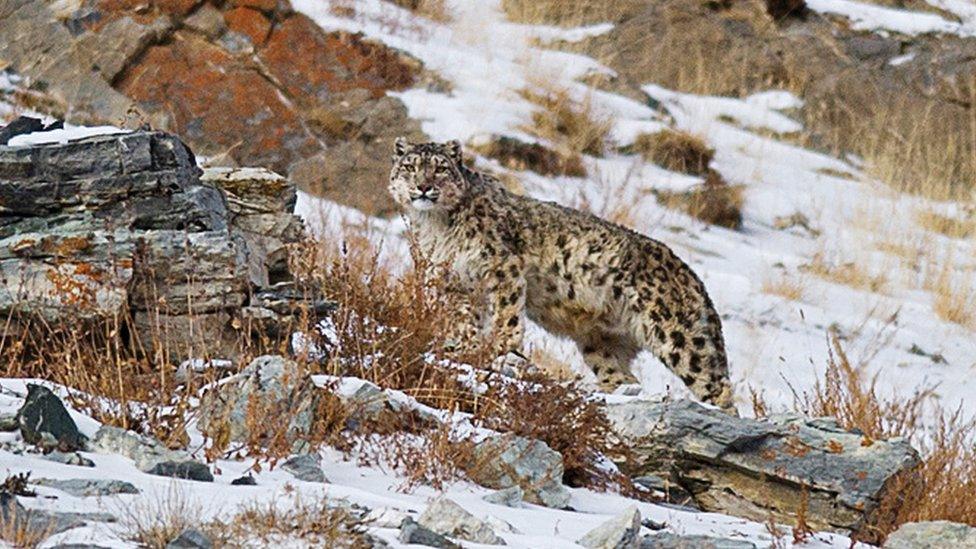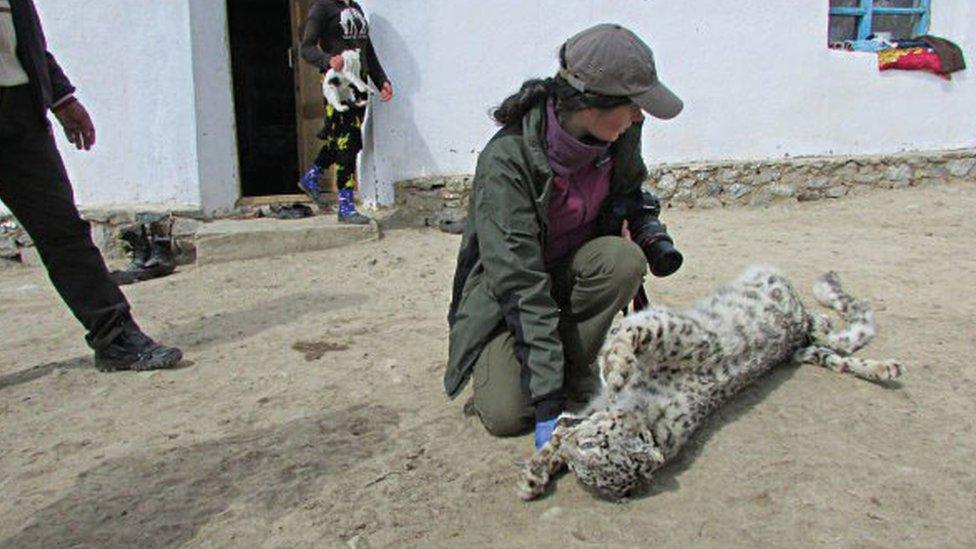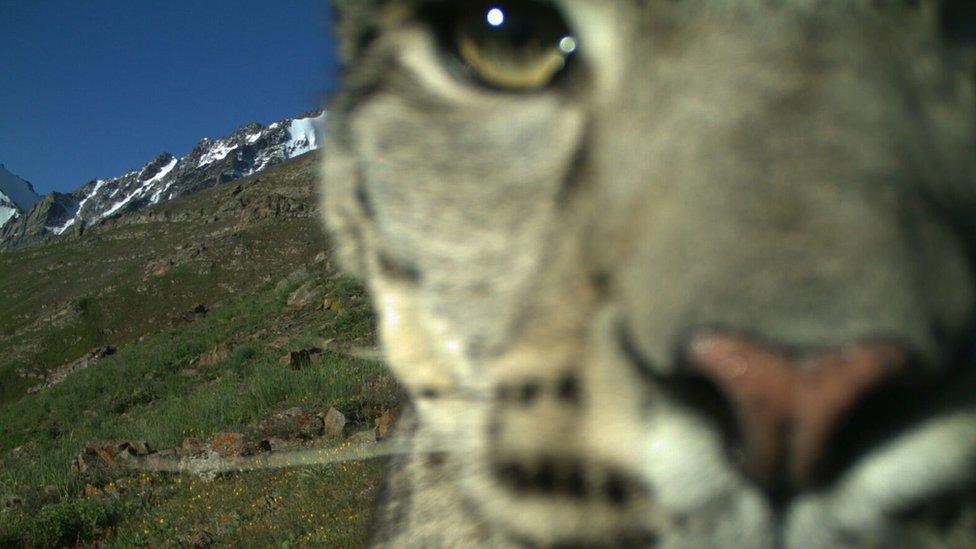Snow leopards: Numbers decline due to 'retaliation'
- Published

Human wildlife conflict has been responsible for the greater number of snow leopards poached in recent years
Hundreds of snow leopards are being killed by poachers every year across the high mountain ranges of Asia, according to a new report.
It's estimated there are just 4,000 of these elegant but elusive creatures now surviving in the wild.
Around four a week are being poached say experts, with most killed by local people in revenge for livestock losses.
The report, external highlights concerns that the illegal trade in snow leopard skins is moving online to evade the law.
Living at altitude
The highly camouflaged snow leopard is found across 12 countries that sweep around the Himalayan and Tibetan plateaus. These include China, Bhutan, Nepal, India, Pakistan as well as Mongolia, Tajikistan and Russia.

The animals can survive in the cold thanks to their thick hairy coats and furry feet
The animals normally live at altitudes between 1,000 and 5,400 metres above sea level. Insulated against the cold by thick hair and fur covered feet, these nomadic leopards prey upon blue sheep and mountain ibex and other smaller creatures.
Given that they can kill animals three times their weight, their ability to hunt domestic sheep and cattle brings them into difficulties with farmers across their ranges.
According to this new study between 221 and 450 snow leopards have been poached every year since 2008. The authors say that while that number could be substantially higher, the main cause is human-wildlife conflict.
"We think that what most observations, seizure records and expert opinion shows is that the majority is still happening because of retaliatory killing," said James Compton from Traffic.

The teeth, claws and bones of the snow leopard are in demand as well as their skins
"One of the major interventions to stop that is better protection for livestock, in some of these very remote areas where you have nomad communities and herds of livestock, because that's where the friction takes place."
Over 90% of the reported poaching occurred in just five countries, China, Mongolia, Pakistan, India and Tajikistan. The report also suggests that only 21% of snow leopards were poached specifically for the illegal trade - but there seem to be many expedient attempts to cash in on the value of the skins and bones of these animals when they are killed.

The powerful camouflage of the snow leopard's coat makes them hard to see in snowy, mountainous locations
"The snow leopard doesn't turn up that often in markets, what the report authors have concluded is that it's a bit opportunistic, if a snow leopard is killed and the parts or the pelt is saleable it's almost like getting your own back for the livestock you've lost," said James Compton.
One of the worries is the rise of clandestine sales on social media and e-commerce. As well as skins and furs there is a market online for claws and teeth, which are advertised as having medicinal properties.

This snow leopard was killed by a villager in Tajikistan after it attacked sheep and goats
With a third of the snow leopard's range falling along international borders that have seen considerable conflict in recent years, the report calls for greater cross-border co-operation, especially on law enforcement. At present just a quarter of known cases of poaching are investigated.
The study also calls for greater incentives for local communities to protect these iconic animals.
"Even if there is reduced demand for snow leopard skins, the killing will continue unless we all work together to drastically reduce human-wildlife conflict and ensure that mountain communities can co-exist with snow leopards," said Rishi Sharma, from WWF who is a co-author of the report.
"Compensation schemes and innovative predator-proof corrals are making a difference but we urgently need to expand these to benefit communities - and snow leopards - across Asia's high mountains."

Positive steps for the snow leopard
While there is increasing pressure on snow leopards from humans and a changing climate, there have been some successful attempts to reverse these trends.
In Kyrgyzstan, an initiative involving the government and conservationists has seen a former hunting concession in Shamshy turned into a wildlife sanctuary. The growth in the numbers of ibex has seen a number of snow leopards re-enter the area, as evidenced by photographs.

In the Shamshy region of Kyrgyzstan snow leopards have been caught on camera showing that conservation is making a difference
"The first camera trapped images of these elusive big cats to come from the area are a powerful reminder that, if we work together we can secure key wildlife habitats so that species like the snow leopard are given the levels of protection needed to survive," said Sally Case from the David Shepherd Foundation, external, who are working with the Kyrgyz government and the Snow Leopard Trust to develop the Shamshy sanctuary.
While the area is too small to be able to host a sizeable snow leopard population, it could serve as the core of a larger habitat in years to come.
"We are thrilled to see that the snow leopard is already in Shamshy," said Musaev Almaz, from the Kyrgyz government's department of rational use of natural resources.
"This cat is an important part of our national culture and heritage, we are committed to securing its future."

Follow Matt on Twitter @mattmcgrathBBC, external and on Facebook, external.